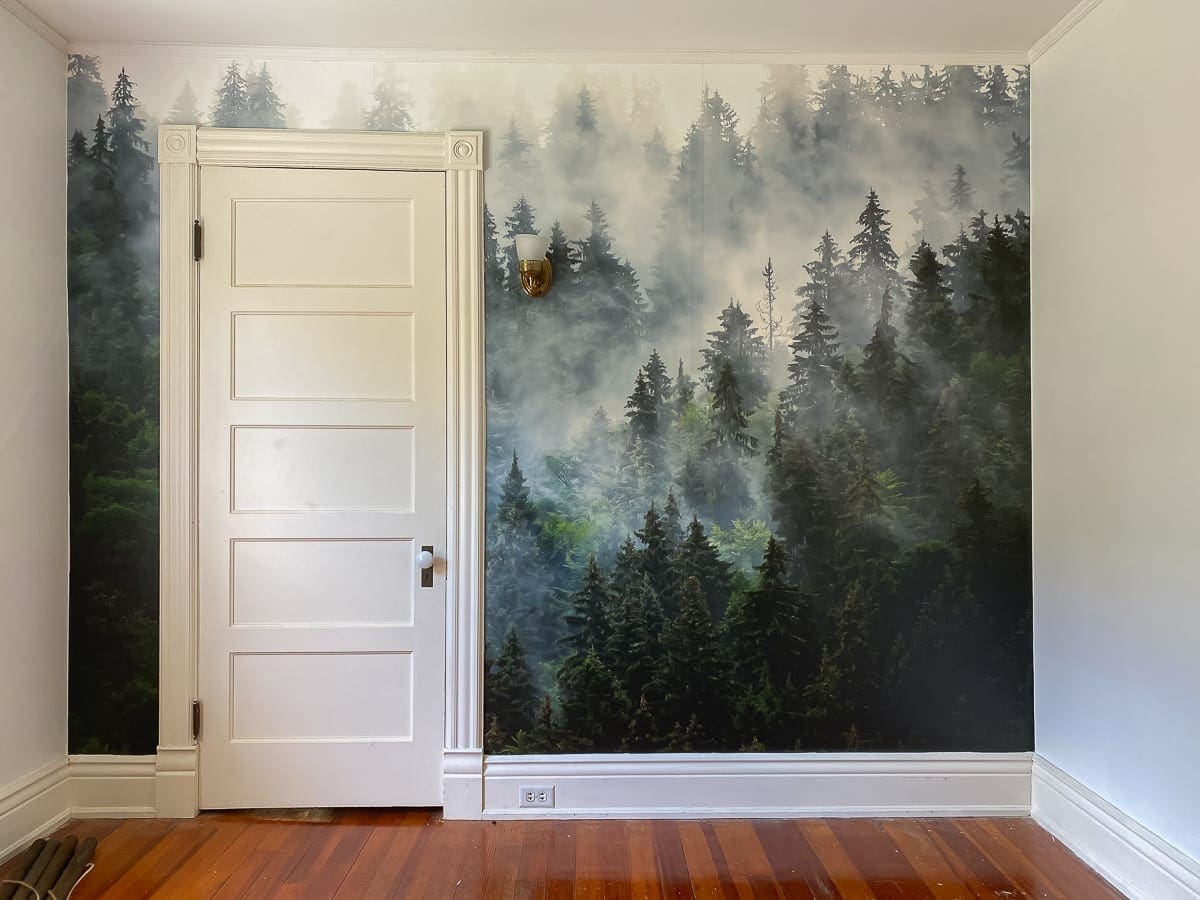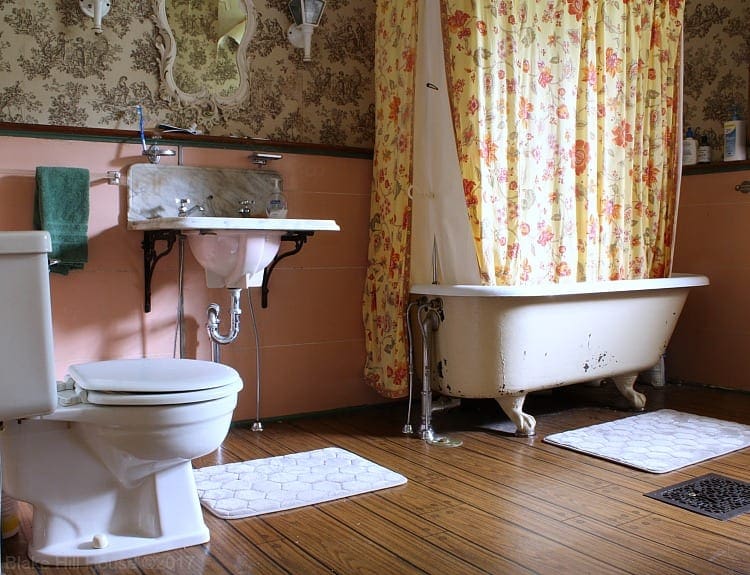This tree mural was a paid collaboration with Limitless Walls. All opinions are my own.
What an exciting week full of progress. Tuesday, I shared the completed dumpster desk makeover, and today, I have another exciting reveal for you. There were plenty of sneak peeks during the dumpster desk video and post, but today is the real deal. There is a gorgeous new tree mural in M’s bedroom, and we owe a sincere thank you to Limitless Walls.

If you remember, way back when we started this bedroom makeover (pre-COVID), my daughter wanted an accent wall of birch tree wallpaper. After the pandemic hit, we had to make some deep cuts to the overall budget, and the accent wall became a “someday, maybe,” item. Then, there was an unexpected turn of events. Limitless Walls, a small mural printing company out of North Carolina, asked if we be interested in a collaboration. Yes, yes, we were.
Longtime followers know I take my collaborations seriously, so before I said yes, I did my research. First, I love that Limitless Walls is a small company. We are all taking a hit during this stupid pandemic, and it is nice when small businesses can help each other.
I was also impressed that there are so many customization options for their products. All of the murals come in made-to-order sizes, and you can even turn your personal photo into art. I think that would be an excellent option for accomplished photographers. Finally, If you cannot find exactly what you want in their extensive catalog, you can work with an artist to bring your dream mural to life.
Ordering the Tree Mural
To help you get your bearings, the tree mural is directly across from the green wall.

Limitless Walls does carry several birch tree murals, but I suggested to my daughter that she broaden her search to trees, to see if anything new caught her eye. Although it is important to me that M. gets to make the decisions in here, I am not above making suggestions when I think there are better options. Birch trees are fine, but I wanted her to look at the project through fresh eyes.
After considering everything from Sequoia trees (Oh, California!) to this variation of birch trees, M. fell in love with Misty Mountain.
There are several ways to adhere a mural to the wall, but we chose peel-and-stick canvas based on the recommendation of the rep from Limitless Walls. He described it as “the thickest and easiest to work with.” Sold.
Our custom mural arrived in three panels.
Installation Supplies
- A level and a pencil
- Utility knife and extra blades
- Smoothing tool (included with purchase)
- Ladder
- Straightedge
Installing the Tree Mural: Day One
First, let me assure you that installing a mural is absolutely doable in one day. We took our time because I didn’t want to ruin my daughter’s enthusiasm for the project. I tend to be very, um, detail-oriented when it comes to hanging wallpaper, and I didn’t want to exhaust my helper. She and I talked it over, and we decided that we would hang one panel, and if we still had energy, we’d do the second one, and so on.
So, we laid out the panels to make a plan. They arrived with labels that designated the top and their numbered position.

We reviewed the installation instructions. The panels are made to overlap. You can leave the overlap, or you can double-cut to match the edges perfectly. Even though the double-cut method looks more professional, we chose to go ahead and stick with the overlap. Honestly, I was not 100% confident in my double-cutting skills, and it felt too risky. Also, the panels are made to overlap working from left to right (labeled 1-3), but we chose to install right to left (labeled 3-1), so we did not have to make complicated cuts on the first panel. Perhaps it is easier left to right, but we like a challenge.
I began by making a vertical level line a panel width’s distance from the wall.

Walls rarely meet ceilings at right angles, especially in an old house. The vertical line keeps the pattern level even when everything else is crooked. If you work directly from the ceiling or wall edge rather than a level line, your pattern could slant a bit, which is very noticeable across a wide expanse or in an entire room.

M. and I held the panel up to the wall as a test.

My job was to work the top of each panel, and M. would do the bottom. She was very concerned that the panel was not exactly on the pencil line all the way down, and the cut along the right edge was going to be a pain since it was only a tiny sliver in some places.

Because the amount of slant was so negligible, I made an executive decision. Despite what I explained above, we opted to use the right side wall to line up the first panel instead of our level line.
We carefully peeled the backing paper down about ten inches, and we began to hang the first panel. I positioned it about three inches above the top edge to account for the ceiling height difference on the left side. The left corner was taller than the right.
M. was in charge of of removing the air bubbles from top to bottom with the smoothing tool. Her attention to detail was on point.

I stood around and watched. The student had become the master.

I knew the other panels were going to be more complicated, so I let her take her time with this one. Smoothing out the bubbles is very satisfying.

After installing the first panel, we were both ready for a break, so we stuck to our plan to take it slow.

Day Two
I’ve worked around a lot of obstacles during wallpaper projects, but sconces are my least favorite. The second panel involved one sconce and cuts around the door. Working from the top down is very difficult with a sconce unless you remove it entirely. I never want to do that because I do not enjoy working with the old wiring in this house. Instead, I just shut off the breaker and let the fixture hang. That’s not the best idea, and I’ll explain why later. Two out of three times, this method has come back to bite me, and still, I persist.
The fixture always leaves a lump, and it makes smoothing from the top down problematic. So, we decided to line up the pattern edge first, and then work top down, diagonally, over to the fixture.
We taped the backing paper to keep it out of the way.

I am including this next photo only because it makes me laugh. We were trying to keep the sticky edge from adhering to the wrong place, and we are short.

M. lined up the pattern carefully. (We are a dream team–Two detail-oriented people working together. Andy, you’re fired. No wait, come back!)

Then, we realized we needed another tall person to hold the upper-left edge of the panel. It kept sagging down, and it was difficult to smooth out the bubbles. We grabbed M’s brother to lend a hand.

When I reached the opening for the light fixture, I carefully cut the paper around it with my blade, and fed the fixture through. (Remember to turn off the breaker.) It wasn’t the prettiest cut I’ve made, but the sconce covers it.

Unfortunately, I dislodged the connections, but we were safe because I turned off the breaker. How many more times can I write that we turned off the breaker? My hanging sconce method is always risky, so do not try it unless you know how to reconnect it, or you have an electrician on the schedule. (Seriously, this idea has only worked one time successfully. What’s wrong with me?)
Once the sconce was out of the way, the panel was flat against the wall again. I smoothed out the air bubbles from the fixture. Then, it was business as usual from the top down.
I went so slowly and carefully with my cuts that my helpers were restless. This is where I mention my attention to detail again. I wear people out; It’s what I do.


I made the general cuts around the door, reinstalled the light fixture, and turned the breaker back on.



Day Three
The third panel was the most difficult to start, but then it was easy. I enlisted my tall helper again. I am lucky that both of these kids put up with my silliness.

Also, if you look closely, you’ll notice that the tall kid finally got a professional post-isolation haircut. During the height of quarantine, I butchered it pretty badly, and it grew out into a weird curly mullet.
For panel three, my son’s role was to keep the top left-edge from sagging. I lined up the pattern and adhered the paper down to the top of the door.

After I cut along the top of the door, the panel dropped into place around the side of the door trim.

Before we pulled off the backing paper, we cut off the huge rectangle that covered the door. It was in the way, and it made trimming around the woodwork more difficult. I left plenty of surplus, but I have enough of that piece left over that I can make a smaller wrapped canvas or something similar. I rolled it up for later.

From this point, the installation was easy. I dismissed my helper and went as slowly as I wanted.

I trimmed the sides first, and then along the bottom of the entire mural.


Finally, I trimmed all the way across the top, and the tree mural was complete.



I’m always afraid to write how-to posts because I am worried they will be boring. However, there is nothing worse than reading a how-to post that barely describes anything. I did not elaborate on my cutting technique in the interest of time, but I went in-depth when I talked about the wallpaper in the front entry and the guest bathroom too. So, if this post isn’t long enough for you, you’ll find more there.
Tree Mural: The Pretty Shots
I was so excited to show my daughter the finished mural. She was thrilled! We both agreed that it looked like we could jump right into it and go hiking.

Calling it pretty doesn’t do justice to its beauty. The texture of the canvas along with the photo gives it so much depth. It looks so real!
Sometimes, when I look at it, it seems sort of dark and stormy.

Other times the light hits it, and it looks like the beginnings of a bright morning instead.

It just keeps changing. M’s plan is to put her new green desk in front of it, so now I can show you the pulled back photos from Tuesday’s reveal.

The colors are pretty perfect.

M. and I are so grateful that we had the opportunity to work with Limitless Walls. The tree mural puts such a gorgeous finishing touch on the room. It has a grown-up feel but it is not too stuffy for a teenager.
I put this short video together. It’s a compilation of the project, and it shows how we talked through some of the installation issues too.
Over the weekend, I will be working on the cabinet and the window. Hopefully, I will have something new to share next week.
If you have any questions, please let me know. I am happy to answer them.






12 Comments
Sherrill
You lucky ladies! That wall looks absolutely beautiful! I love the “tree hugger” shot.
Stacy
Thank you, Sherrill. We are pretty excited about it.
Vanessa
Well done, that is stunning!
Stacy
Thank you, Vanessa. We can’t get over how real it looks!
Maureen
Nice work, M. I think that’s what Habitat for Humanity calls “Sweat Equity.”
I like the tree hugger photo too.
Limitless Walls looks like a winner here.
Stacy
It’s sweat equity for sure. 🙂
Sara M.
This turned out beautifully! Great work❤️
Stacy
Thank you, Sara!
Laura
Oh, I love this tutorial! I’m glad that you discussed the old-house problem of walls and ceilings that aren’t perfectly straight. Great job, team!
Stacy
I’m glad it was helpful. If you have additional questions about compensating for old house problems, let me know. 🙂 I am never quite sure if I am clear enough in my writing.
Lori
I have coveted that paper forever and it looks so fantastic installed! I didn’t realize you could get a canvas option– I love the extra texture it adds that makes it not look so much like wallpaper.
Stacy
The canvas is so nice! The mural is reusable too. I will never have another wall quite like this one, but I could remove it and use parts of it somewhere else.